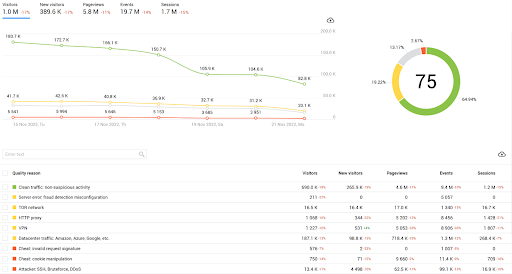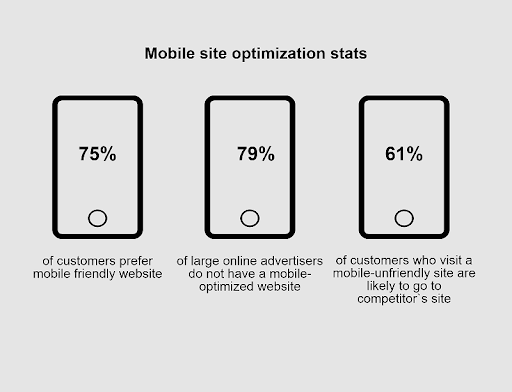Rebecca Barnatt-Smith
Rebecca is a freelance journalist and multi-media marketing executive, specialising in the future of social media marketing and immersive technology in business.
Unveil the power of webmaster tools by reading this article. Enhance e-commerce performance and skyrocket your site's traffic in 2023.
The e-commerce landscape is expanding exponentially. With up to 24 million live stores dominating the world wide web, it’s no surprise that the competition for conversions has skyrocketed.
Staying on top of your e-commerce marketing has now become essential in the race to gain visibility. From improving your search engine visibility to optimizing your site for mobile devices, the list of SEO tips and tricks for site success has become endless.
However, in 2023, staying on track with your site SEO has never been easier. Using webmaster tools such as Google Search Console, you can quickly collect valuable insights into how your traffic engages with your search engine.
The question is, how can we use these insights to improve e-commerce performance? Stick with us as we delve into the webmaster tools every site owner should invest in and reveal why they could be the traffic booster you’ve been looking for.
According to TechTarget, “a webmaster is someone who creates and manages the content and organization of a website, manages the computer server and technical programming aspects of a website or does both.”
Enhancing your site management with webmaster tools can aid webmasters in collating large groups of site data in seconds and constructing detailed reports that a business can follow in real-time.
The question is, what types of webmaster tools are on the market? Let’s have a look:
Whether you monitor your backlink engagement or your audience’s behavioral analytics, webmaster tools are pivotal in influencing UX design, content campaigns and mobile optimization.
Prioritizing site monitoring can improve e-commerce marketing in several ways. If you have constant access to traffic-based data, trending keywords and bounce rate stats, it’s much easier to identify what your site is doing right and, more importantly, what it is doing wrong.
Don’t believe us? Here are three ways webmaster tools could transform your site performance for your e-commerce audience.
Search engine-generated webmaster tools such as Google Search Console and Bing Webmaster are the perfect partners in identifying potential site issues that could impede your success.
Plenty of factors could affect your website’s performance. These factors range from broken links to crawl errors. Spotting these issues manually can be tricky. However, webmaster tools can highlight technical faults in seconds. They bring these faults to a webmaster's attention.
For example, webmasters can use Google Search Console to see their site’s linking profile and easily spot potentially toxic backlinks to low-authority sites.
“Poor engagement statistics paired with ‘crawl ability’ issues and other technical issues are all indications of low authority according to Google,” says the marketing director at ParadoxLabs, Ashley M. Orndorff.
“If your site is considered irrelevant and is not deemed useful to visitors, it’s not going to rank in the search engines. Search engines are businesses too, and their business is showing the most relevant resources to their users.”
Webmaster tools can help build a site that is easier to crawl and contains links to relevant, useful content for e-commerce visitors.
It’s common knowledge that the business closest to their consumers wins, so having the ability to learn more about your audience profiles and what makes them tick and click could be a game-changer on the road to e-commerce victory.
Audience-based webmaster tools, such as Finteza, offer valuable insights into your target audience and their site-based behavior. These tools can track the duration of their on-site activity, their interactions with your website, the points where they drop off in the conversion funnel, and the overall quality of traffic.

Finteza takes this one step further, tracking and segmenting your audience data before splitting its findings into 15 basic parameters ranging from percentage of lost users by pages to geographical location.
If you want to increase your conversion rate, Finteza’s traffic monetization system can also help you find out when you lose leads and suggest why they may drop off the conversion funnel pre-checkout.
By accessing real-time visitor statistics, you can observe traffic engagement patterns in tables, charts, or histograms. This facilitates the identification of behavioral trends that can inform re-targeting campaigns for checkout drop-offs.
Moreover, Finteza's comprehensive webmaster features enable the detection of bot traffic and inaccessible site points. This ensures more precise insights into your target audience. Additionally, it alerts webmasters about 400, 403, 404, and 500-type errors that may impede webpage browsing.
With more audience data, you’ll quickly become an expert on demographic trends, traffic source locations and the profile of your ideal target consumer.
In an e-commerce landscape where one-third of consumers demand personalization, getting close to your customer is always the answer, especially if you want to keep your retention rates high.
It’s no secret that online shopping has become smartphone centered. With more people tapping into Google via mobile devices, 75% of customers prefer a mobile-friendly website.

“It’s important to make sure your site is lean and loads fast, as that’s important on mobile,” states Matt Cutts, Google’s head of Web spam.
Therefore, if your site offers users a poor smartphone-based user experience, potential leads will quickly click off, increasing your site’s bounce rate.
Webmaster tools play a crucial role in addressing mobile-centric usability issues. They can identify such issues and offer real-time, actionable recommendations, enabling faster resolution of mobile-based experience drawbacks.
For instance, Google Search Console provides dedicated mobile-site reports. Webmasters can easily spot SEO sinkholes, including image optimization and button placements that may seem functional on a computer screen.

In a mobile usability report, Google ranks mobile optimization issues by counting the number of affected site pages. For example, while an image may be too small for a mobile visitor on one page, a dysfunctional navigation bar would become a pressing issue sitewide.
“As the consumer’s device of choice, mobile is almost always on hand,” says Carin van Vuuren, CMO at Usablenet. “It’s the brand’s first point of contact with the consumer, but that doesn’t mean forcing them to walk around with the entire website in your pocket.
Rather, the mobile experience needs to address the context of a mobile user.” With the ability to point a webmaster in the right direction when improving their mobile optimization, GSC is a great web design partner, especially in an era of smartphone-centered e-commerce.
Webmaster tools continue to make site monitoring easier for e-commerce businesses. As traffic potential expands globally, tracking visitor data and engagement stats without the help of analytic technology is impossible.
Tracking your site traffic has never been easier. If you want to see your site stats climb in real-time, webmaster tools provide users with a wide-scale snapshot of what their online store is doing right and where it needs to improve to move onto that all-important first results page.
For those who want to improve their search rankings, webmaster tools allow a marketer to view their website like Google would.
“Webmaster tools provide you with information on things like the search queries that helped people find your website, traffic stats, possible tweaks that could help your website rank better, number of indexed URLs, number of links pointing to your website and those within your website,” say experts at Brand Dignity.
“Think of it as a powerful tool for an SEO audit and one that helps prevent the common SEO mistakes that people routinely make if you follow some of its recommendations.”
Whether you use webmaster tools to identify and fix your technical issues or instead choose to monitor your search engine rankings and your audience behavior, those who invest in data-led optimization will see success in a competitive e-commerce arena.
You’ll also receive some of our best posts today

Rebecca is a freelance journalist and multi-media marketing executive, specialising in the future of social media marketing and immersive technology in business.
Research reveals 80% of top brands have invested in...

User reviews are a game-changer for e-commerce. Consumers rely heavily o...
Don’t miss the new articles!